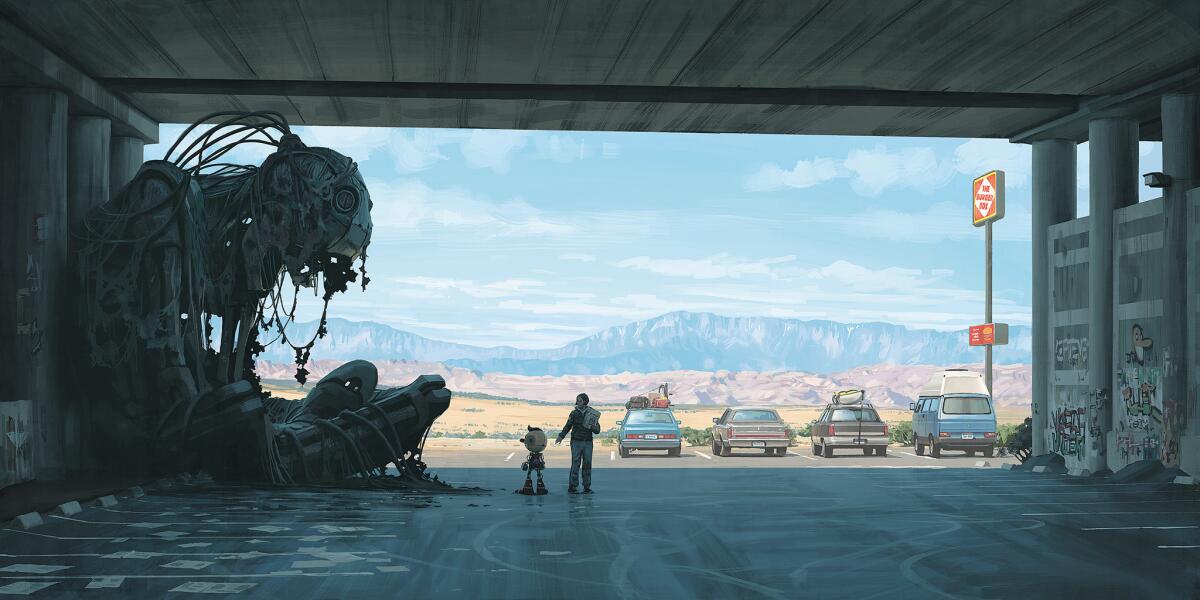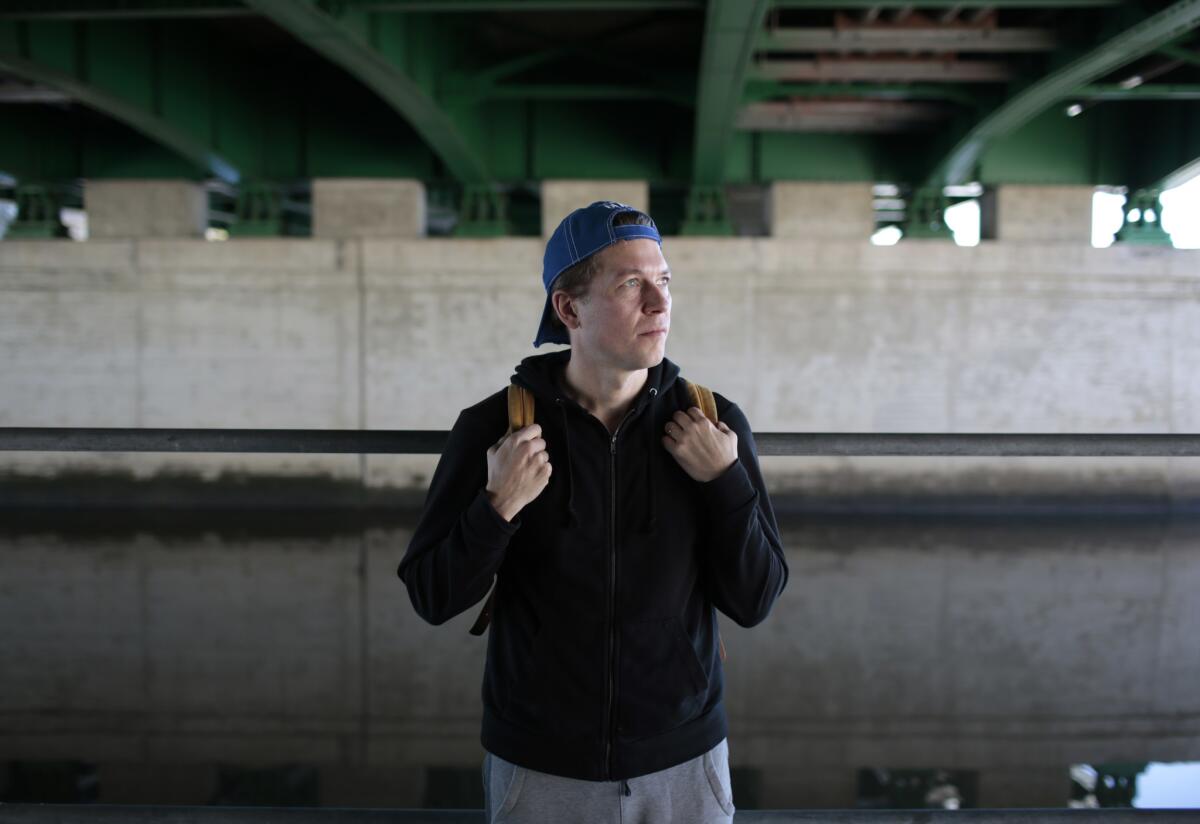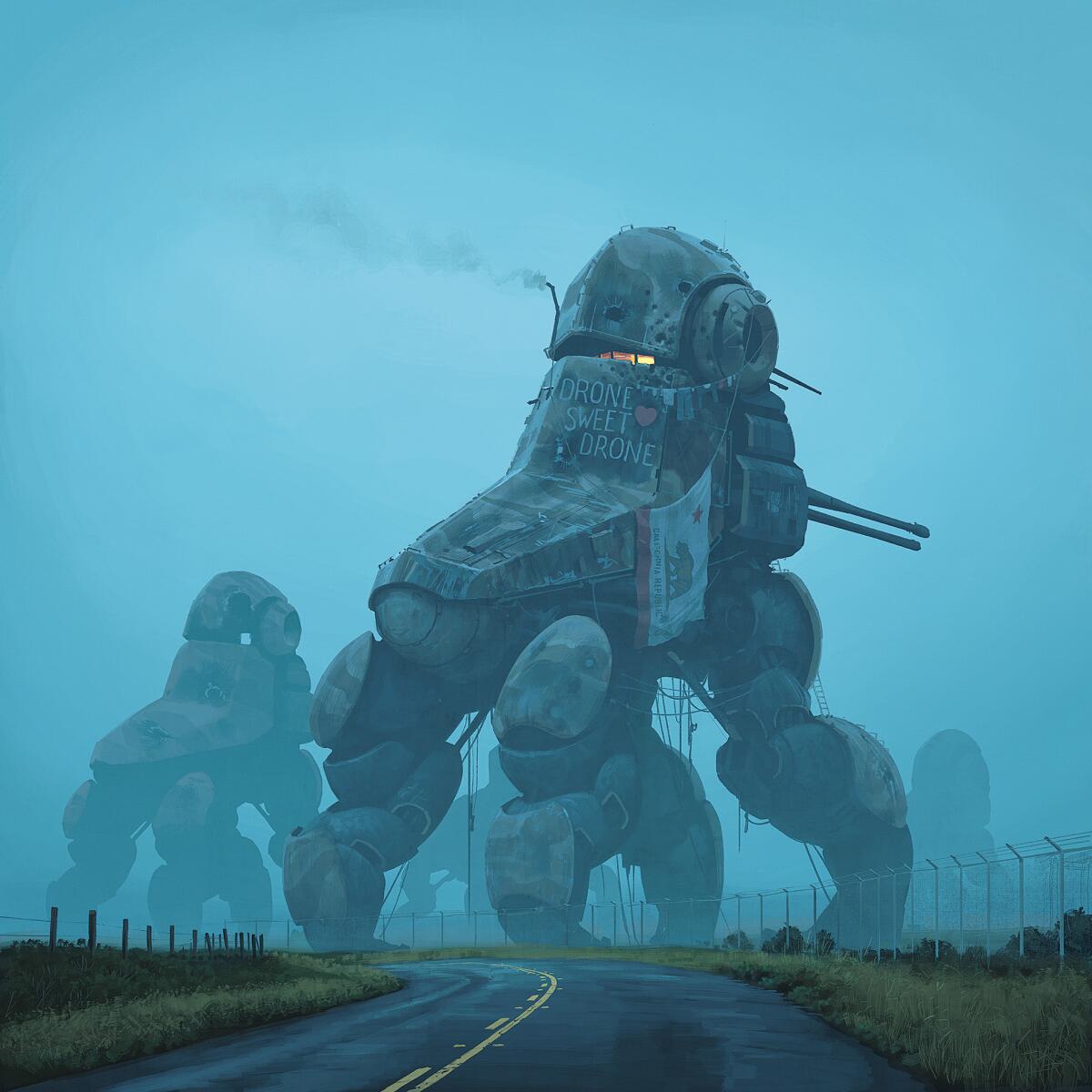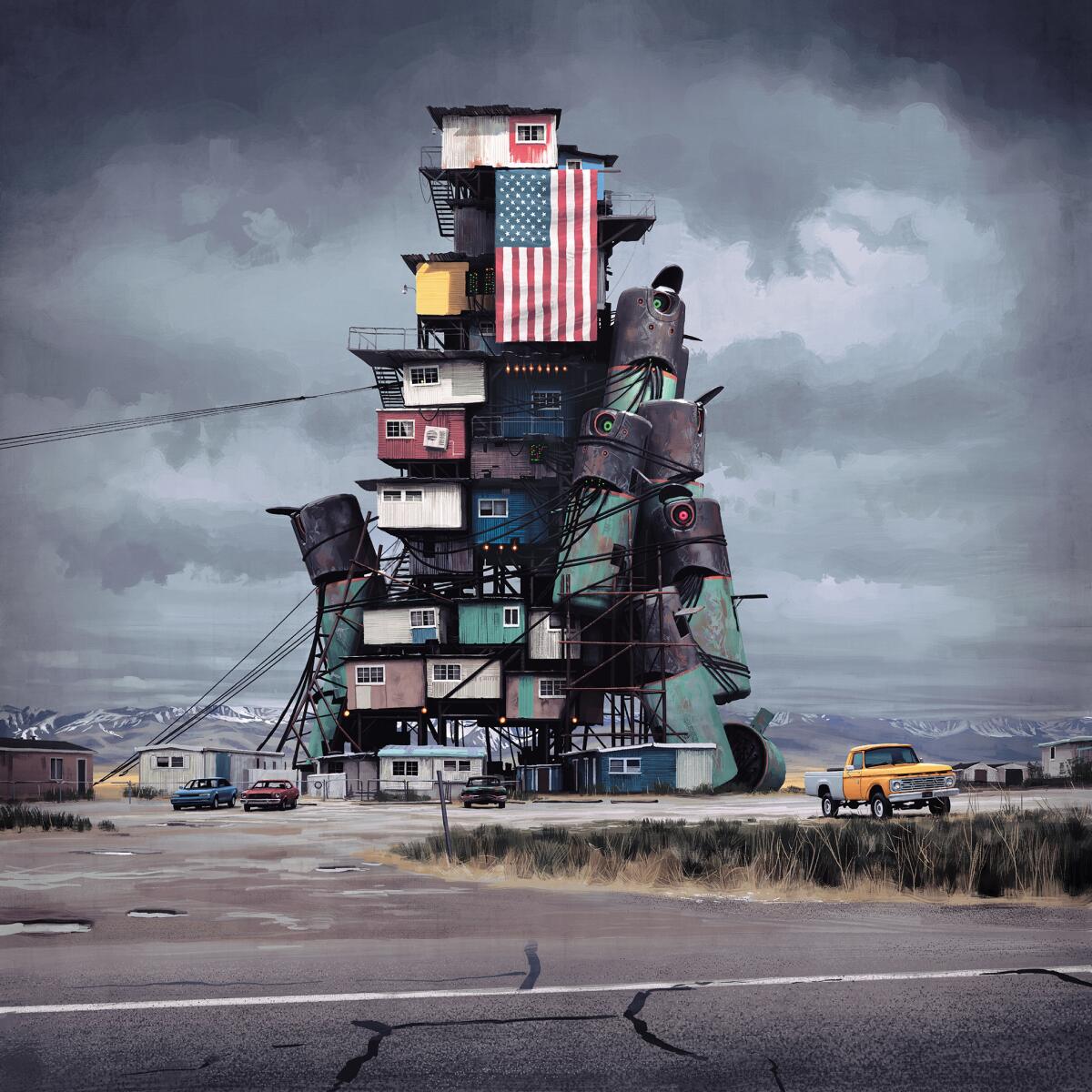Road trip through post-apocalyptic California with a robot and a runaway in Simon Stålenhag’s ‘The Electric State’
- Share via
While sitting outside a Marina del Rey coffee shop one recent afternoon, Swedish sci-fi artist and author Simon Stålenhag shares the unlikely source of his inspiration: “It started with Nirvana,” he says. “I wanted to do a science fiction thing where Nirvana makes sense."
His alternative-universe graphic novel “The Electric State” follows a young woman and a robot traveling along highways familiar to California road-trippers. But in Stålenhag’s dystopian world set in 1997, our region is called Pacifica, and the country has been ravaged by drone war. A VR-like technology has also zapped the life from users. Yet, it's also a world where rock bands like Nirvana and the Beatles have existed and where recognizable corporate logos, like Longs Drugs, dot the landscape alongside fictional brands.
Known for narrative art that mixes realistic landscapes with 20th century nostalgia and science fiction elements, Stålenhag has amassed a cult following and critical acclaim for his inventive and captivating work. He even crowdfunded his book projects through Kickstarter campaigns, which brought his digitally-distributed artwork into the analog world.
“The Electric State” was released in late 2018 through Skybound Books — the imprint formed by “Walking Dead” creator Robert Kirkman's Skybound Entertainment — and Simon & Schuster's Atria Books. Yet interest around Stålenhag’s works has been growing; the Russo brothers — the sibling director duo who recently made “Avengers: Infinity War” — landed the film rights for the book in late 2017. In addition to “The Electric State” deal, Amazon has ordered a first season of “Tales From the Loop,” another graphic project based on Stålenhag's earlier sci-fi art.


Stålenhag had been in Los Angeles with his wife for the past few months for what he describes as a "nice work-cation." He has some book signings scheduled and has been taking in meetings. He's also working on a new story, which he says is set in a bunker.
Where his earlier art was steeped in his native Sweden, though, Stålenhag looked to the U.S. for “The Electric State.” The book is dystopian '90s at its most bleak. It's the gloom of “Twin Peaks” and the detached alienation of Nirvana’s “Nevermind” with a plot that reads like “The X-Files”-meets-“The Lawnmower Man.” It's also a travel tale, taking readers from the Mojave Desert and up through the Sierra Nevada mountains before heading toward the Northern California coast.
"I think the first idea I had was, what if Kurt Cobain went on a road trip," he says. In a way, that stuck for a bit. While working on the book, he referred to the protagonist as "Negative Creep," after a song on Nirvana's debut album, “Bleach,” before settling on the name Michelle.

When “The Electric State” was just a germ of an idea, Stålenhag hit California's roads with his wife and his mom. They traveled from San Francisco to Los Angeles, then headed to the desert. They ventured into the tiny town of Bishop and into the vast expanses of Yosemite. Stålenhag's mom drove, while he took pictures from the front seat. Some of the potential location shots weren't usable — "Everything from Monterey and south was just too sunny and pretty," he says — but Northern California was perfect. It reminded him of The “X-Files,” which was one of his inspirations for the book.
"I guess I'm a very emotional artist," Stålenhag says. "It takes a while before I intellectualize what I'm going to do." The inspiration, he says, always comes from his childhood. From there, he tries to figure out why those inspirations trigger certain feelings. It's a process he describes as similar to dowsing for water. He'll make playlists on Spotify that reflect the era he's trying to capture. He'll take photos, then begin sketching over them. Once he has a few images, he'll share them on Twitter to see if others connect in the same way.

In the process of making “The Electric State,” Stålenhag used social media to ask readers about places that existed in the '90s, like the chain drugstores and markets that pop up in the background. He shared some of the art as works in progress and says a lot of people commented that one design looked a lot like a Dalek, the villainous alien beings from “Doctor Who.” Stålenhag had never seen the famed British sci-fi series, but changed the design.
The full project can be quite immersive. Stålenhag is also an electronic musician whose ambient compositions are tied to his visual art and writing. For “The Electric State,” he made a corresponding soundtrack album. (His most recent album, “Music For DOS,” was made with now-vintage gear that he learned to use as an adolescent. It was released last summer.)
The first idea I had was, what if Kurt Cobain went on a road trip?
— Simon Stålenhag
“The Electric State's” protagonist, Michelle, is inspired by Stålenhag's older brother and sister. His brother was a Nirvana fan, while his sister listened to the band REM. They passed the teen pop culture of the era down to Stålenhag. Michelle's own protective, nurturing relationship with her younger brother is also inspired by the elder siblings. "My parents divorced when I was 10, so I guess the last four or five years of their marriage was pretty bad," says Stålenhag, who was born in 1984. "My siblings, to some extent, took care of me and were kind of the adults for a while." He adds that he wanted to make his book “about that kind of love that you have for your siblings," while incorporating the pop culture elements of the 1990s.

That mix of science fiction and real world pop-culture nostalgia is instantly compelling, but there are layers to “The Electric State” that take the story beyond surface value. Michelle's journey is told in the first person with frequent use of flashbacks to her life before she left home for Pacifica. The war is technically over, but the aftermath has been marred by its own strain of chaos. In a way, it is an extremely American story, bringing together themes like the intersection of war and technology; fire-and-brimstone religion and its effect on LGBT youth; families separated by great physical distance while still being a part of the same country.
And, yet, there's a universality to the story.
Michelle may be young, but she has already suffered profound loss multiple times. She has been let down by life in ways that are extreme but relatable to many. "The emotional apocalypse has already happened to her, so when it actually starts happening around her, she's already adapted," Stålenhag says. "She's a very good survivor."
It's a story that's not bogged down with details; the minutia of 1990s California probably wouldn't have worked anyhow. "I didn't want to write about local, specific stuff because that would feel wrong," says Stålenhag. "Those kinds of things, you can't really research, you have to live them."
Instead, he tapped into his own teenage emotions and let it evolve from there.
"I just trusted that people are the same," says Stålenhag.
::
Simon Stålenhag
Skybound Books; 144 pp., $35
Sign up for our Book Club newsletter
Get the latest news, events and more from the Los Angeles Times Book Club, and help us get L.A. reading and talking.
You may occasionally receive promotional content from the Los Angeles Times.







